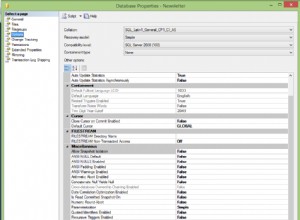Dans SQL Server, le changement de partition vous permet de charger très rapidement de grandes quantités de données dans ou hors d'une table. Cela vous évite d'avoir à exécuter des instructions de suppression ou d'insertion et peut être très utile lorsque vous travaillez avec de grands ensembles de données.
Vous pouvez utiliser le ALTER TABLE instruction pour basculer une partition dans ou hors d'une table.
Pour sortir une partition d'une table, le code ressemble à ceci :
ALTER TABLE Table1
SWITCH PARTITION x TO Table2
Cela change la partition x de Table1 à Table2 (où x est le numéro de la partition).
Exemple
La configuration
Avant de commencer à changer, nous allons créer la configuration de base. Celui-ci sera composé de deux tableaux. L'une sera la table source partitionnée, l'autre sera la table de destination. Nous allons également créer quatre groupes de fichiers - un pour chaque partition.
-- Create filegroups
ALTER DATABASE Test ADD FILEGROUP OrdersLatestFg1;
GO
ALTER DATABASE Test ADD FILE (
NAME = OrdersLatestFg1dat,
FILENAME = '/var/opt/mssql/data/OrdersLatestFg1dat.ndf',
SIZE = 5MB,
MAXSIZE = 100MB,
FILEGROWTH = 5MB
)
TO FILEGROUP OrdersLatestFg1;
GO
ALTER DATABASE Test ADD FILEGROUP OrdersLatestFg2;
GO
ALTER DATABASE Test ADD FILE (
NAME = OrdersLatestFg2dat,
FILENAME = '/var/opt/mssql/data/OrdersLatestFg2dat.ndf',
SIZE = 5MB,
MAXSIZE = 100MB,
FILEGROWTH = 5MB
)
TO FILEGROUP OrdersLatestFg2;
GO
ALTER DATABASE Test ADD FILEGROUP OrdersLatestFg3;
GO
ALTER DATABASE Test ADD FILE (
NAME = OrdersLatestFg3dat,
FILENAME = '/var/opt/mssql/data/OrdersLatestFg3dat.ndf',
SIZE = 5MB,
MAXSIZE = 100MB,
FILEGROWTH = 5MB
)
TO FILEGROUP OrdersLatestFg3;
GO
ALTER DATABASE Test ADD FILEGROUP OrdersLatestFg4;
GO
ALTER DATABASE Test ADD FILE (
NAME = OrdersLatestFg4dat,
FILENAME = '/var/opt/mssql/data/OrdersLatestFg4dat.ndf',
SIZE = 5MB,
MAXSIZE = 100MB,
FILEGROWTH = 5MB
)
TO FILEGROUP OrdersLatestFg4;
GO
-- Create a partition function that will result in four partitions
CREATE PARTITION FUNCTION OrdersLatestPartitionFunction (date)
AS RANGE RIGHT FOR VALUES (
'20200201',
'20200301',
'20200401'
);
GO
-- Create a partition scheme that maps the partitions to the filegroups
CREATE PARTITION SCHEME OrdersLatestPartitionScheme
AS PARTITION OrdersLatestPartitionFunction
TO (
OrdersLatestFg1,
OrdersLatestFg2,
OrdersLatestFg3,
OrdersLatestFg4
);
GO
-- Create a partitioned table called OrdersLatest that uses the OrderDate column as the partitioning column
CREATE TABLE OrdersLatest (
OrderDate date NOT NULL,
OrderId int IDENTITY NOT NULL,
OrderDesc varchar(255) NOT NULL,
CONSTRAINT PKOrdersLatest PRIMARY KEY CLUSTERED(OrderDate, OrderId)
)
ON OrdersLatestPartitionScheme(OrderDate);
GO
-- Insert data into the OrdersLatest table.
-- This will end up in partition 3, which is the partition we will switch out to the OrdersMarch table.
INSERT INTO OrdersLatest(OrderDate, OrderDesc) VALUES
('20200302', 'Cat food'),
('20200315', 'Water bowl'),
('20200318', 'Saddle for camel'),
('20200321', 'Dog biscuits'),
('20200328', 'Bigfoot shoes');
GO
-- Create a table that contains the data that we will be switching out to.
-- Note that the filegroup matches the filegroup of the partition that we will switch out of.
CREATE TABLE OrdersMarch (
OrderDate date NOT NULL,
OrderId int IDENTITY NOT NULL,
OrderDesc varchar(255) NOT NULL,
CONSTRAINT PKOrdersMarch PRIMARY KEY CLUSTERED(OrderDate, OrderId)
)
ON OrdersLatestFg3;
GO
-- Check how many rows are in each table
SELECT COUNT(*) AS OrdersLatest
FROM OrdersLatest;
SELECT COUNT(*) AS OrdersMarch
FROM OrdersMarch;Résultat :
+----------------+ | OrdersLatest | |----------------| | 5 | +----------------+ +---------------+ | OrdersMarch | |---------------| | 0 | +---------------+
Donc, dans l'état actuel des choses, nous avons cinq lignes dans le OrdersLatest table, qui est notre table partitionnée.
Les cinq lignes doivent être dans la partition 3. Vérifions cela.
SELECT
p.partition_number AS [Partition],
fg.name AS [Filegroup],
p.Rows
FROM sys.partitions p
INNER JOIN sys.allocation_units au
ON au.container_id = p.hobt_id
INNER JOIN sys.filegroups fg
ON fg.data_space_id = au.data_space_id
WHERE p.object_id = OBJECT_ID('OrdersLatest')
ORDER BY [Partition];Résultat :
+-------------+-----------------+--------+ | Partition | Filegroup | Rows | |-------------+-----------------+--------| | 1 | OrdersLatestFg1 | 0 | | 2 | OrdersLatestFg2 | 0 | | 3 | OrdersLatestFg3 | 5 | | 4 | OrdersLatestFg4 | 0 | +-------------+-----------------+--------+
Oui, nous pouvons donc voir que les cinq lignes sont dans la partition 3. Nous pouvons également voir que la partition 3 est mappée sur OrdersLatestFg3 groupe de fichiers. Pour que notre "commutation" réussisse, nous devons nous assurer que notre table de destination utilise ce groupe de fichiers. Heureusement, notre code ci-dessus fait exactement cela. Nous avons utilisé ON OrdersLatestFg3 lors de la création de la table afin de spécifier que la table doit être créée sur ce groupe de fichiers.
Éteindre
OK, donc tout est prêt à s'éteindre. Allons-y.
ALTER TABLE OrdersLatest
SWITCH PARTITION 3 TO OrdersMarch;Résultat :
Commands completed successfully.
Excellent. Notre changement a fonctionné.
Vérifions à nouveau le nombre de lignes dans chaque tableau.
SELECT COUNT(*) AS OrdersLatest
FROM OrdersLatest;
SELECT COUNT(*) AS OrdersMarch
FROM OrdersMarch;Résultat :
+----------------+ | OrdersLatest | |----------------| | 0 | +----------------+ +---------------+ | OrdersMarch | |---------------| | 5 | +---------------+
Nous pouvons donc voir que les données ont été déplacées du OrdersLatest table vers OrdersMarch tableau.
Vérifions les informations de partition pour OrdersLatest .
SELECT
p.partition_number AS [Partition],
fg.name AS [Filegroup],
p.Rows
FROM sys.partitions p
INNER JOIN sys.allocation_units au
ON au.container_id = p.hobt_id
INNER JOIN sys.filegroups fg
ON fg.data_space_id = au.data_space_id
WHERE p.object_id = OBJECT_ID('OrdersLatest')
ORDER BY [Partition];Résultat :
+-------------+-----------------+--------+ | Partition | Filegroup | Rows | |-------------+-----------------+--------| | 1 | OrdersLatestFg1 | 0 | | 2 | OrdersLatestFg2 | 0 | | 3 | OrdersLatestFg3 | 0 | | 4 | OrdersLatestFg4 | 0 | +-------------+-----------------+--------+
Comme prévu, le OrdersLatestFg3 la partition est maintenant vide. C'est parce qu'il a été désactivé.
Vérifions les informations de partition pour le OrdersMarch tableau.
SELECT
p.partition_number AS [Partition],
fg.name AS [Filegroup],
p.Rows
FROM sys.partitions p
INNER JOIN sys.allocation_units au
ON au.container_id = p.hobt_id
INNER JOIN sys.filegroups fg
ON fg.data_space_id = au.data_space_id
WHERE p.object_id = OBJECT_ID('OrdersMarch')
ORDER BY [Partition];Résultat :
+-------------+-----------------+--------+ | Partition | Filegroup | Rows | |-------------+-----------------+--------| | 1 | OrdersLatestFg3 | 5 | +-------------+-----------------+--------+
Là encore, comme prévu, la table OrdersMarch contient cinq lignes. Ils sont stockés dans la partition 1 (la seule partition) sur le OrdersLatest3 groupe de fichiers.
Mise en marche
Voir Activer une partition dans SQL Server pour savoir comment activer une partition.




